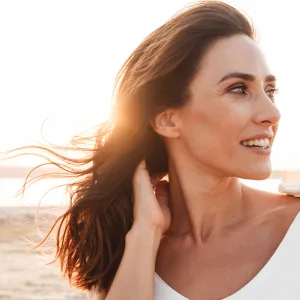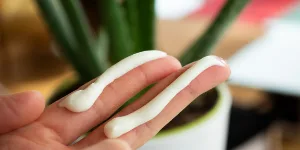Sun protection advice
Main page:Skin topics
article.category:Healthy Skin
As soon as the sun shines, you get the inner calling to go outside and catch some rays. The slight tingling on the skin, the feeling of warmth, new energy and strength. A gloriously happy moment in time. But despite all of these positive sensations, you should tread cautiously.

Product characteristics
-
Cruelty-Free
-
UVA/UVB-Protection
-
Vegan
UVA and UVB rays – the dark side of the sun
As much as we love the sun, as much do we want to avoid wrinkles and age spots. We go to some lengths to keep youthful and smooth skin. Because we aim to stay young for as long as possible. Nothing costs too much or takes too much time. Serums, face creams, eye creams, peelings, masks and cleansing products. We have them all and use them all. But despite taking good care, small, and sometimes even big, wrinkles start to appear. The problem is that we tend to forget one crucial factor, namely our beautiful sun and its dark side.
Catching some sun is a real mood booster. UV light also stimulates the production of vitamin D and strengthens the immune system. The dark side: UVA rays are able to penetrate deep into the skin where they attack the supporting structure made from collagen and elastin. Even if this does not show right from the start, the UVA rays accelerate the whole ageing process and are responsible for the early appearance of wrinkles. Unlike UVA rays, UVB rays cause painful sunburn. As soon as we tan for too long without sun cream, the skin no longer browns but burns instead. The sun rays are reflected more strongly and their effect is more intensive in the water, on concrete or in the snow. And remember that the skin is exposed to the sun all year round, even on foggy and rainy days. To optimally protect the skin against the sun and its UV rays, it is therefore important to know how long your skin can protect itself.
Your skin’s own protection and sun protection
Your skin’s own protection is the time it can stay in the sun unprotected without being damaged. As no two skins are the same, this time depends on the skin type. As a basic rule, the darker the skin, eyes and hair, the greater the skin’s own protection. Extremely pale-skinned persons can stay in the sun for around 5 to 10 minutes, whereas extremely dark-skinned persons can be protected for more than 90 minutes. If you want to spend long periods outdoors, you need to protect yourself against the sun. Clothing, hats, sunglasses and shade help, but sun cream is the only protection that lasts for longer periods of time. Sun cream leaves a film on your skin, thus protecting it against harmful environmental factors.
When sunbathing, it is important to use sufficient cream and select the right sun protection factor for your skin. Sun cream with too low a sun protection factor quickly stops protecting extremely pale skin. To find a suitable sun cream, multiply the number of minutes your skin can protect itself with the sun protection factor of the sun cream. The minutes and hours thus calculated are the time the skin is protected against damage. An extremely pale-skinned person whose skin can protect itself for 10 minutes, could increase the time spent in the sun up to 500 minutes when using sun protection factor 50, for example.
General use of sun protection products
To achieve maximum protection, sun cream has to be applied liberally approximately 30 minutes before going outdoors. It is recommended to reapply sun cream after spending long periods of time in the water or on the sand.
Apply sufficient sun protection
Sun protection products should be applied sufficiently. This is the only way to achieve optimal protection
- 1 finger length for face
- 2 finger lengths for body

